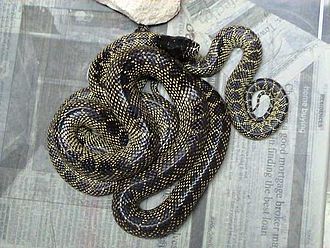Type the name of the breed you're looking for below
[wpdreams_ajaxsearchlite] Don't see the breed your're looking for? Click here and let us know!
Desert Kingsnake
| Place of Origin and Range | Found in desert and grasslands from southern Texas west to south eastern Arizona. |
| Description | A black to brown king snake with sides speckled in white, cream, or yellow. The dark back is crossed at regular intervals by a series of thin cross bars that link with the speckled sides. A yellow speckled snake with black background. |
| Morph Patterns Available | Yes |
| Adult Size | Can grow to 4 feet (1.2m) |
| Accommodation | Arid rocky, grassland or desert habitats work well. High humidity (between 60-80%), branches for climbing and sun bathing. A minimum of two hides, one warm and a cooler one. Snakes are cold blooded animals and regulate their body heat by soaking in the sun or hiding in the shade. A Day basking Lamp(basking spot 80'F(27'C)or some snake owners prefer under tank heating. Also you want to include a bathing dish big enough for your snake to climb in without overflowing. |
| Lifespan | Can live 15-20 years |
| Feeding / Diet | King snakes use constriction to kill their prey and tend to be opportunistic when it comes to their diet; they will eat other snakes, including venomous snakes. King snakes will also eat lizards, rodents, birds, and eggs. The common king snake is known to be immune to the venom of other snakes and to eat rattlesnakes, but it is not necessarily immune to the venom of snakes from different localities. |
| Other Considerations | Snakes are relatively hardy low maintenance animals when kept in the correct environment, and require little day to day care other than feeding and cleaning out the tank as required. However, like all animals, they can still become sick or injured despite our best intentions to prevent this. |



